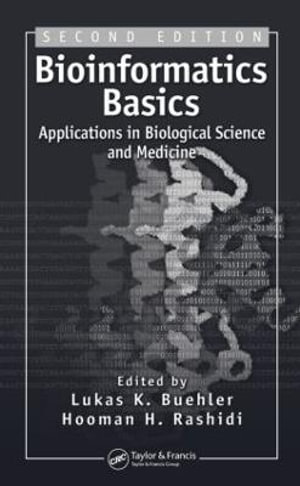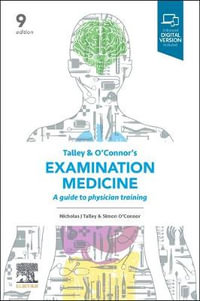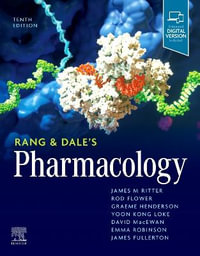
Bioinformatics Basics
Applications in Biological Science and Medicine
By: Hooman H. Rashidi (Editor), Lukas K. Buehler (Editor)
Hardcover | 23 June 2005 | Edition Number 2
At a Glance
368 Pages
New edition
23.4 x 15.6 x 3.18
Hardcover
RRP $378.00
$314.25
17%OFF
or 4 interest-free payments of $78.56 with
orAvailable for Backorder. We will order this from our supplier however there isn't a current ETA.
The first editon of Bioinformatics Basics: Applications in Biological Science and Medicine answered the scientific communityâs need to learn about the bioinformatic tools available to them. That the book continues to be a best seller clearly demonstrates the authorsâ ability to provide scientists with the understanding to apply those tools to their research. Currently, it is being used as a reference text at MIT and other prestigious institutions.
Recognizing the important advances in bioinformatices since their last edition, Buehler and Rashidi have produced a completely revised and updated version of their pioneering work. To allow scientists to utilize significant databases from around the world, the authors consider some fresh approaches to data analysis while identifying computing techniques that will help them manage the massive flow of information their science requires.
New to the second edition:
Bioinformatics Basics is not intended to serve as a training manual for bioinformaticians. Instead, itâs designed to help the general scientific community gain a thorough understanding of what bioinformatics tools are ava
| Biology and Information | p. 1 |
| Bioinformatics-A Rapidly Maturing Science | p. 1 |
| From Genes to Proteins | p. 2 |
| Bioinformatics in the Public Domain | p. 7 |
| Computers in Biology and Medicine | p. 12 |
| Computational Tools | p. 12 |
| Limitations of Computational Tools | p. 18 |
| References | p. 23 |
| The Virtual Doctor | p. 23 |
| Mapping the Human Brain | p. 25 |
| References | p. 30 |
| Biological Macromolecules as Information Carriers | p. 30 |
| References | p. 34 |
| Proteins: From Sequence to Structure to Function | p. 34 |
| Molecular Interaction in Protein Structures | p. 35 |
| The Peptide Bond | p. 35 |
| Characteristics of the Peptide Bond | p. 37 |
| The Hydrophobic Effect and How It Contributes to Protein Folding | p. 39 |
| Electrostatic Interactions | p. 41 |
| Hydrogen Bonding | p. 41 |
| Conformational Entropy | p. 42 |
| Van der Waals Interactions (Packing) | p. 42 |
| Covalent Bonds (e.g., Disulfide Bridge) | p. 42 |
| Protein Functions | p. 42 |
| Enzymes | p. 42 |
| Regulatory Proteins | p. 43 |
| Storage | p. 43 |
| Transportation | p. 43 |
| Signaling | p. 43 |
| Immunity | p. 44 |
| Structural | p. 44 |
| References | p. 44 |
| DNA and RNA Structure | p. 45 |
| The DNA Double Helix | p. 46 |
| Genomic Size of DNA | p. 48 |
| References | p. 49 |
| DNA Cloning and Sequencing | p. 49 |
| DNA Cloning | p. 50 |
| Transcriptional Profiling | p. 51 |
| Positional Cloning and Chromosome Mapping | p. 52 |
| Polymerase Chain Reaction (PCR) | p. 54 |
| Sequencing Technologies | p. 55 |
| References | p. 56 |
| Genes, Taxonomy, and Evolution | p. 56 |
| References | p. 61 |
| Biological Databases | p. 63 |
| Biological Database Organization | p. 63 |
| Database Content and Management | p. 63 |
| Data Submissions | p. 64 |
| The Growth of Public Databases | p. 68 |
| Data Retrieval | p. 70 |
| References | p. 74 |
| Data Annotation and Database Connectivity | p. 75 |
| Annotation | p. 76 |
| Redundancy | p. 78 |
| Public Databases | p. 79 |
| National Center for Biotechnology Information (NCBI) | p. 79 |
| Who is Employed by NCBI? | p. 81 |
| What Kind of Research is Conducted at NCBI? | p. 81 |
| What Types of Databases are Supported by NCBI? | p. 81 |
| What Do We Mean by Redundancy? | p. 82 |
| What are Some of the Services Offered by NCBI? | p. 84 |
| References | p. 89 |
| European Bioinformatics Institute (EBI) | p. 90 |
| Who is Employed by EBI? | p. 90 |
| What Kind of Research is Conducted at EBI? | p. 90 |
| What Are Some Of The Services Offered By EBI? | p. 92 |
| References | p. 101 |
| Kyoto Encyclopedia of Genes and Genomes (KEGG) | p. 102 |
| Classification of Biological Molecules | p. 112 |
| Cellular Processes at KEGG | p. 114 |
| References | p. 117 |
| Database Mining Tools | p. 118 |
| Sequence Similarity Search Tools: BLAST and FASTA | p. 118 |
| Shared Characteristics in Both Sequence Alignment Tools | p. 120 |
| How are Sequence Alignments Useful? | p. 121 |
| Basic Local Alignment Search Tool (BLAST) | p. 122 |
| An Overview of Database Sequence Searching | p. 129 |
| References | p. 131 |
| Pattern Recognition Tools (Prosite) | p. 132 |
| The Significance of Embedded Symbols within Each Signature and How to Read and Construct Signatures | p. 133 |
| References | p. 134 |
| Multiple Alignment and Phylogenetic Tree Analysis | p. 134 |
| References | p. 137 |
| Genome Analysis | p. 139 |
| The Genomic Organization of Genes | p. 139 |
| What are Genomes? | p. 139 |
| Mapping and Navigating Genomes | p. 142 |
| Genetic Linkage Maps | p. 147 |
| Physical Maps | p. 149 |
| From Sequence Maps to Gene Function Maps | p. 154 |
| References | p. 154 |
| The Genome Projects | p. 155 |
| How Many Genes are in a Genome? | p. 158 |
| References | p. 164 |
| The Human Genome | p. 164 |
| References | p. 169 |
| Comparative Genomics | p. 170 |
| Cluster of Orthologous Groups (COGs) | p. 170 |
| Homologene at NCBI | p. 176 |
| References | p. 182 |
| Gene Order and Chromosome Rearrangements | p. 182 |
| MapViewer | p. 183 |
| References | p. 185 |
| Functional Genomics | p. 185 |
| The Transcriptome | p. 185 |
| Microarray and Bioarray Technology | p. 190 |
| Concept and Use | p. 190 |
| Summary of a Typical Experiment Using Microarray Technology | p. 191 |
| Microarray Bioinformatics | p. 191 |
| Image Processing | p. 194 |
| References | p. 195 |
| Data Annotation | p. 195 |
| References | p. 196 |
| Data Analysis | p. 196 |
| Experiment Design/Plan | p. 197 |
| Volume of Data | p. 197 |
| Dimensionality of Data | p. 199 |
| Quality of Data | p. 199 |
| Normalization | p. 199 |
| Statistical Analysis | p. 199 |
| Explorative Analysis | p. 202 |
| Aim of Clustering | p. 202 |
| Biological Interpretation of Clustering Results | p. 202 |
| Theory of Clustering | p. 202 |
| Clustering vs. Classification (Unsupervised vs. Supervised) | p. 203 |
| Main Types of Clustering | p. 203 |
| Hierarchical Clustering | p. 203 |
| Nonhierarchical Clustering | p. 204 |
| Other Clustering or Classification Algorithms | p. 206 |
| Advice on Using Clustering | p. 206 |
| References | p. 207 |
| Data Storage | p. 208 |
| References | p. 209 |
| Data Mining | p. 209 |
| Protein Arrays | p. 209 |
| Concluding Remarks | p. 211 |
| Genomes as Gene Networks | p. 211 |
| References | p. 216 |
| Proteome Analysis | p. 217 |
| Proteomics | p. 217 |
| What is a Proteome? | p. 217 |
| 2-D Gels and Mass Spectrometry Tools | p. 219 |
| 2-D PAGE at Expasy (Swiss Bioinformatics Institute) | p. 221 |
| References | p. 225 |
| Hydrodynamic Methods | p. 226 |
| Introduction | p. 226 |
| Analytical Ultracentrifugation | p. 228 |
| Experimental Setup and Instrumentation | p. 228 |
| Transport Processes in The AUC Cell | p. 229 |
| Analytical Ultracentrifuge (AUC) Experiments | p. 234 |
| Light Scattering | p. 246 |
| Experimental Setup and Instrumentation | p. 246 |
| Dynamic Light Scattering | p. 247 |
| Static Light Scattering | p. 250 |
| Global Analysis | p. 252 |
| Appendix | p. 254 |
| References | p. 255 |
| Predictive Biology | p. 256 |
| Protein Structure Prediction | p. 256 |
| Structure Prediction Software | p. 266 |
| References | p. 269 |
| Structural Genomics | p. 269 |
| References | p. 276 |
| Rational Drug Design | p. 276 |
| References | p. 285 |
| Systems Biology | p. 285 |
| Protein Interaction Networks | p. 285 |
| References | p. 290 |
| Metabolic Reconstruction | p. 290 |
| References | p. 295 |
| The Bioinformatics Revolution in Medicine | p. 297 |
| Genes and Diseases | p. 297 |
| From Molecules to Diseases | p. 297 |
| References | p. 303 |
| Online Mendelian Inheritance in Man (OMIM) | p. 303 |
| References | p. 308 |
| Pharmacogenomics | p. 308 |
| Agricultural Genomics | p. 309 |
| Genetically Modified Organisms | p. 312 |
| References | p. 313 |
| Biopharming | p. 313 |
| References | p. 316 |
| Glossary of Biological Terms | p. 317 |
| Bioinformatics Web Sites | p. 323 |
| Index | p. 325 |
| Table of Contents provided by Ingram. All Rights Reserved. |
ISBN: 9780849312830
ISBN-10: 0849312833
Published: 23rd June 2005
Format: Hardcover
Language: English
Number of Pages: 368
Audience: Professional and Scholarly
Publisher: Taylor & Francis Inc
Country of Publication: GB
Edition Number: 2
Edition Type: New edition
Dimensions (cm): 23.4 x 15.6 x 3.18
Weight (kg): 0.76
Shipping
| Standard Shipping | Express Shipping | |
|---|---|---|
| Metro postcodes: | $9.99 | $14.95 |
| Regional postcodes: | $9.99 | $14.95 |
| Rural postcodes: | $9.99 | $14.95 |
How to return your order
At Booktopia, we offer hassle-free returns in accordance with our returns policy. If you wish to return an item, please get in touch with Booktopia Customer Care.
Additional postage charges may be applicable.
Defective items
If there is a problem with any of the items received for your order then the Booktopia Customer Care team is ready to assist you.
For more info please visit our Help Centre.
You Can Find This Book In

FREE SHIPPING
RRP $39.95
$31.90
OFF






















